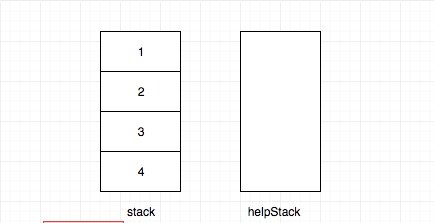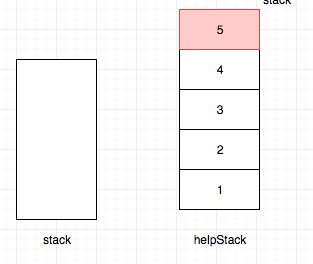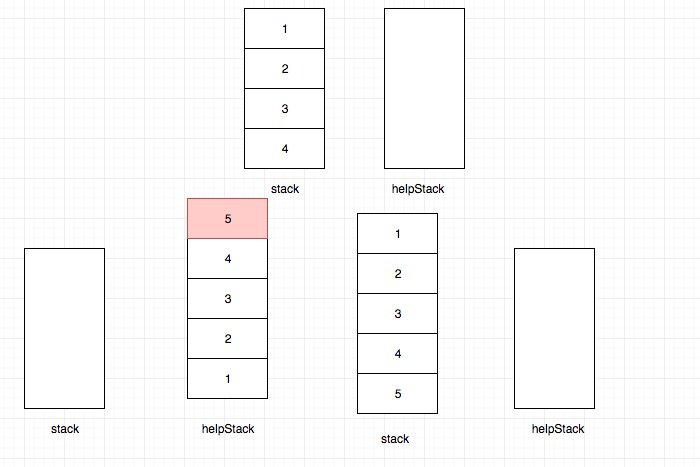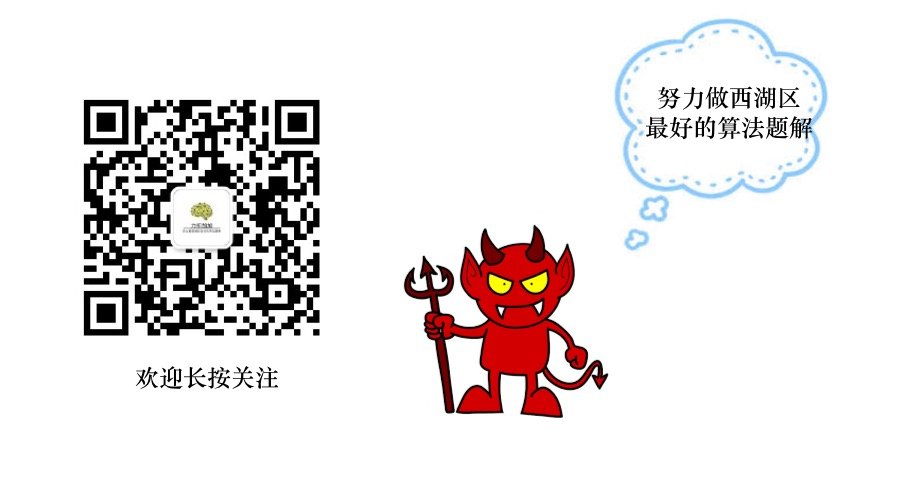# 0232. 用栈实现队列
## 题目地址(232. 用栈实现队列)
<https://leetcode-cn.com/problems/implement-queue-using-stacks/>
## 题目描述
```
<pre class="calibre18">```
使用栈实现队列的下列操作:
push(x) -- 将一个元素放入队列的尾部。
pop() -- 从队列首部移除元素。
peek() -- 返回队列首部的元素。
empty() -- 返回队列是否为空。
示例:
MyQueue queue = new MyQueue();
queue.push(1);
queue.push(2);
queue.peek(); // 返回 1
queue.pop(); // 返回 1
queue.empty(); // 返回 false
说明:
你只能使用标准的栈操作 -- 也就是只有 push to top, peek/pop from top, size, 和 is empty 操作是合法的。
你所使用的语言也许不支持栈。你可以使用 list 或者 deque(双端队列)来模拟一个栈,只要是标准的栈操作即可。
假设所有操作都是有效的 (例如,一个空的队列不会调用 pop 或者 peek 操作)。
```
```
## 前置知识
- [栈](https://github.com/azl397985856/leetcode/blob/master/thinkings/basic-data-structure.md)
## 公司
- 阿里
- 腾讯
- 百度
- 字节
- bloomberg
- microsoft
## 思路
这道题目是让我们用栈来模拟实现队列。 我们知道栈和队列都是一种受限的数据结构。 栈的特点是只能在一端进行所有操作,队列的特点是只能在一端入队,另一端出队。
在这里我们可以借助另外一个栈,也就是说用两个栈来实现队列的效果。这种做法的时间复杂度和空间复杂度都是O(n)。
由于栈只能操作一端,因此我们peek或者pop的时候也只去操作顶部元素,要达到目的 我们需要在push的时候将队头的元素放到栈顶即可。
因此我们只需要在push的时候,用一下辅助栈即可。 具体做法是先将栈清空并依次放到另一个辅助栈中,辅助栈中的元素再次放回栈中,最后将新的元素push进去即可。
比如我们现在栈中已经是1,2,3,4了。 我们现在要push一个5.
push之前是这样的:

然后我们将栈中的元素转移到辅助栈:

最后将新的元素添加到栈顶。

整个过程是这样的:

## 关键点解析
- 在push的时候利用辅助栈(双栈)
## 代码
- 语言支持:JS, Python, Java
Javascript Code:
```
<pre class="calibre18">```
<span class="hljs-title">/*
* @lc app=leetcode id=232 lang=javascript
*
* [232] Implement Queue using Stacks
*/</span>
<span class="hljs-title">/**
* Initialize your data structure here.
*/</span>
<span class="hljs-keyword">var</span> MyQueue = <span class="hljs-function"><span class="hljs-keyword">function</span>(<span class="hljs-params"></span>) </span>{
<span class="hljs-title">// tag: queue stack array</span>
<span class="hljs-keyword">this</span>.stack = [];
<span class="hljs-keyword">this</span>.helperStack = [];
};
<span class="hljs-title">/**
* Push element x to the back of queue.
* @param {number} x
* @return {void}
*/</span>
MyQueue.prototype.push = <span class="hljs-function"><span class="hljs-keyword">function</span>(<span class="hljs-params">x</span>) </span>{
<span class="hljs-keyword">let</span> cur = <span class="hljs-params">null</span>;
<span class="hljs-keyword">while</span> ((cur = <span class="hljs-keyword">this</span>.stack.pop())) {
<span class="hljs-keyword">this</span>.helperStack.push(cur);
}
<span class="hljs-keyword">this</span>.helperStack.push(x);
<span class="hljs-keyword">while</span> ((cur = <span class="hljs-keyword">this</span>.helperStack.pop())) {
<span class="hljs-keyword">this</span>.stack.push(cur);
}
};
<span class="hljs-title">/**
* Removes the element from in front of queue and returns that element.
* @return {number}
*/</span>
MyQueue.prototype.pop = <span class="hljs-function"><span class="hljs-keyword">function</span>(<span class="hljs-params"></span>) </span>{
<span class="hljs-keyword">return</span> <span class="hljs-keyword">this</span>.stack.pop();
};
<span class="hljs-title">/**
* Get the front element.
* @return {number}
*/</span>
MyQueue.prototype.peek = <span class="hljs-function"><span class="hljs-keyword">function</span>(<span class="hljs-params"></span>) </span>{
<span class="hljs-keyword">return</span> <span class="hljs-keyword">this</span>.stack[<span class="hljs-keyword">this</span>.stack.length - <span class="hljs-params">1</span>];
};
<span class="hljs-title">/**
* Returns whether the queue is empty.
* @return {boolean}
*/</span>
MyQueue.prototype.empty = <span class="hljs-function"><span class="hljs-keyword">function</span>(<span class="hljs-params"></span>) </span>{
<span class="hljs-keyword">return</span> <span class="hljs-keyword">this</span>.stack.length === <span class="hljs-params">0</span>;
};
<span class="hljs-title">/**
* Your MyQueue object will be instantiated and called as such:
* var obj = new MyQueue()
* obj.push(x)
* var param_2 = obj.pop()
* var param_3 = obj.peek()
* var param_4 = obj.empty()
*/</span>
```
```
Python Code:
```
<pre class="calibre18">```
<span class="hljs-class"><span class="hljs-keyword">class</span> <span class="hljs-title">MyQueue</span>:</span>
<span class="hljs-function"><span class="hljs-keyword">def</span> <span class="hljs-title">__init__</span><span class="hljs-params">(self)</span>:</span>
<span class="hljs-string">"""
Initialize your data structure here.
"""</span>
self.stack = []
self.help_stack = []
<span class="hljs-function"><span class="hljs-keyword">def</span> <span class="hljs-title">push</span><span class="hljs-params">(self, x: int)</span> -> <span class="hljs-keyword">None</span>:</span>
<span class="hljs-string">"""
Push element x to the back of queue.
"""</span>
<span class="hljs-keyword">while</span> self.stack:
self.help_stack.append(self.stack.pop())
self.help_stack.append(x)
<span class="hljs-keyword">while</span> self.help_stack:
self.stack.append(self.help_stack.pop())
<span class="hljs-function"><span class="hljs-keyword">def</span> <span class="hljs-title">pop</span><span class="hljs-params">(self)</span> -> int:</span>
<span class="hljs-string">"""
Removes the element from in front of queue and returns that element.
"""</span>
<span class="hljs-keyword">return</span> self.stack.pop()
<span class="hljs-function"><span class="hljs-keyword">def</span> <span class="hljs-title">peek</span><span class="hljs-params">(self)</span> -> int:</span>
<span class="hljs-string">"""
Get the front element.
"""</span>
<span class="hljs-keyword">return</span> self.stack[<span class="hljs-params">-1</span>]
<span class="hljs-function"><span class="hljs-keyword">def</span> <span class="hljs-title">empty</span><span class="hljs-params">(self)</span> -> bool:</span>
<span class="hljs-string">"""
Returns whether the queue is empty.
"""</span>
<span class="hljs-keyword">return</span> <span class="hljs-keyword">not</span> bool(self.stack)
<span class="hljs-title"># Your MyQueue object will be instantiated and called as such:</span>
<span class="hljs-title"># obj = MyQueue()</span>
<span class="hljs-title"># obj.push(x)</span>
<span class="hljs-title"># param_2 = obj.pop()</span>
<span class="hljs-title"># param_3 = obj.peek()</span>
<span class="hljs-title"># param_4 = obj.empty()</span>
```
```
Java Code
```
<pre class="calibre18">```
<span class="hljs-class"><span class="hljs-keyword">class</span> <span class="hljs-title">MyQueue</span> </span>{
Stack<Integer> pushStack = <span class="hljs-keyword">new</span> Stack<> ();
Stack<Integer> popStack = <span class="hljs-keyword">new</span> Stack<> ();
<span class="hljs-title">/** Initialize your data structure here. */</span>
<span class="hljs-function"><span class="hljs-keyword">public</span> <span class="hljs-title">MyQueue</span><span class="hljs-params">()</span> </span>{
}
<span class="hljs-title">/** Push element x to the back of queue. */</span>
<span class="hljs-function"><span class="hljs-keyword">public</span> <span class="hljs-keyword">void</span> <span class="hljs-title">push</span><span class="hljs-params">(<span class="hljs-keyword">int</span> x)</span> </span>{
<span class="hljs-keyword">while</span> (!popStack.isEmpty()) {
pushStack.push(popStack.pop());
}
pushStack.push(x);
}
<span class="hljs-title">/** Removes the element from in front of queue and returns that element. */</span>
<span class="hljs-function"><span class="hljs-keyword">public</span> <span class="hljs-keyword">int</span> <span class="hljs-title">pop</span><span class="hljs-params">()</span> </span>{
<span class="hljs-keyword">while</span> (!pushStack.isEmpty()) {
popStack.push(pushStack.pop());
}
<span class="hljs-keyword">return</span> popStack.pop();
}
<span class="hljs-title">/** Get the front element. */</span>
<span class="hljs-function"><span class="hljs-keyword">public</span> <span class="hljs-keyword">int</span> <span class="hljs-title">peek</span><span class="hljs-params">()</span> </span>{
<span class="hljs-keyword">while</span> (!pushStack.isEmpty()) {
popStack.push(pushStack.pop());
}
<span class="hljs-keyword">return</span> popStack.peek();
}
<span class="hljs-title">/** Returns whether the queue is empty. */</span>
<span class="hljs-function"><span class="hljs-keyword">public</span> <span class="hljs-keyword">boolean</span> <span class="hljs-title">empty</span><span class="hljs-params">()</span> </span>{
<span class="hljs-keyword">return</span> pushStack.isEmpty() && popStack.isEmpty();
}
}
<span class="hljs-title">/**
* Your MyQueue object will be instantiated and called as such:
* MyQueue obj = new MyQueue();
* obj.push(x);
* int param_2 = obj.pop();
* int param_3 = obj.peek();
* boolean param_4 = obj.empty();
*/</span>
`
```
```
**复杂度分析**
- 时间复杂度:O(1)O(1)O(1)
- 空间复杂度:O(1)O(1)O(1)
## 扩展
- 类似的题目有用队列实现栈,思路是完全一样的,大家有兴趣可以试一下。
- 栈混洗也是借助另外一个栈来完成的,从这点来看,两者有相似之处。
## 延伸阅读
实际上现实中也有使用两个栈来实现队列的情况,那么为什么我们要用两个stack来实现一个queue?
其实使用两个栈来替代一个队列的实现是为了在多进程中分开对同一个队列对读写操作。一个栈是用来读的,另一个是用来写的。当且仅当读栈满时或者写栈为空时,读写操作才会发生冲突。
当只有一个线程对栈进行读写操作的时候,总有一个栈是空的。在多线程应用中,如果我们只有一个队列,为了线程安全,我们在读或者写队列的时候都需要锁住整个队列。而在两个栈的实现中,只要写入栈不为空,那么`push`操作的锁就不会影响到`pop`。
- [reference](https://leetcode.com/problems/implement-queue-using-stacks/discuss/64284/Do-you-know-when-we-should-use-two-stacks-to-implement-a-queue)
- [further reading](https://stackoverflow.com/questions/2050120/why-use-two-stacks-to-make-a-queue/2050402#2050402)
更多题解可以访问我的LeetCode题解仓库:<https://github.com/azl397985856/leetcode> 。 目前已经37K star啦。
关注公众号力扣加加,努力用清晰直白的语言还原解题思路,并且有大量图解,手把手教你识别套路,高效刷题。

- Introduction
- 第一章 - 算法专题
- 数据结构
- 基础算法
- 二叉树的遍历
- 动态规划
- 哈夫曼编码和游程编码
- 布隆过滤器
- 字符串问题
- 前缀树专题
- 《贪婪策略》专题
- 《深度优先遍历》专题
- 滑动窗口(思路 + 模板)
- 位运算
- 设计题
- 小岛问题
- 最大公约数
- 并查集
- 前缀和
- 平衡二叉树专题
- 第二章 - 91 天学算法
- 第一期讲义-二分法
- 第一期讲义-双指针
- 第二期
- 第三章 - 精选题解
- 《日程安排》专题
- 《构造二叉树》专题
- 字典序列删除
- 百度的算法面试题 * 祖玛游戏
- 西法的刷题秘籍】一次搞定前缀和
- 字节跳动的算法面试题是什么难度?
- 字节跳动的算法面试题是什么难度?(第二弹)
- 《我是你的妈妈呀》 * 第一期
- 一文带你看懂二叉树的序列化
- 穿上衣服我就不认识你了?来聊聊最长上升子序列
- 你的衣服我扒了 * 《最长公共子序列》
- 一文看懂《最大子序列和问题》
- 第四章 - 高频考题(简单)
- 面试题 17.12. BiNode
- 0001. 两数之和
- 0020. 有效的括号
- 0021. 合并两个有序链表
- 0026. 删除排序数组中的重复项
- 0053. 最大子序和
- 0088. 合并两个有序数组
- 0101. 对称二叉树
- 0104. 二叉树的最大深度
- 0108. 将有序数组转换为二叉搜索树
- 0121. 买卖股票的最佳时机
- 0122. 买卖股票的最佳时机 II
- 0125. 验证回文串
- 0136. 只出现一次的数字
- 0155. 最小栈
- 0167. 两数之和 II * 输入有序数组
- 0169. 多数元素
- 0172. 阶乘后的零
- 0190. 颠倒二进制位
- 0191. 位1的个数
- 0198. 打家劫舍
- 0203. 移除链表元素
- 0206. 反转链表
- 0219. 存在重复元素 II
- 0226. 翻转二叉树
- 0232. 用栈实现队列
- 0263. 丑数
- 0283. 移动零
- 0342. 4的幂
- 0349. 两个数组的交集
- 0371. 两整数之和
- 0437. 路径总和 III
- 0455. 分发饼干
- 0575. 分糖果
- 0874. 模拟行走机器人
- 1260. 二维网格迁移
- 1332. 删除回文子序列
- 第五章 - 高频考题(中等)
- 0002. 两数相加
- 0003. 无重复字符的最长子串
- 0005. 最长回文子串
- 0011. 盛最多水的容器
- 0015. 三数之和
- 0017. 电话号码的字母组合
- 0019. 删除链表的倒数第N个节点
- 0022. 括号生成
- 0024. 两两交换链表中的节点
- 0029. 两数相除
- 0031. 下一个排列
- 0033. 搜索旋转排序数组
- 0039. 组合总和
- 0040. 组合总和 II
- 0046. 全排列
- 0047. 全排列 II
- 0048. 旋转图像
- 0049. 字母异位词分组
- 0050. Pow(x, n)
- 0055. 跳跃游戏
- 0056. 合并区间
- 0060. 第k个排列
- 0062. 不同路径
- 0073. 矩阵置零
- 0075. 颜色分类
- 0078. 子集
- 0079. 单词搜索
- 0080. 删除排序数组中的重复项 II
- 0086. 分隔链表
- 0090. 子集 II
- 0091. 解码方法
- 0092. 反转链表 II
- 0094. 二叉树的中序遍历
- 0095. 不同的二叉搜索树 II
- 0096. 不同的二叉搜索树
- 0098. 验证二叉搜索树
- 0102. 二叉树的层序遍历
- 0103. 二叉树的锯齿形层次遍历
- 105. 从前序与中序遍历序列构造二叉树
- 0113. 路径总和 II
- 0129. 求根到叶子节点数字之和
- 0130. 被围绕的区域
- 0131. 分割回文串
- 0139. 单词拆分
- 0144. 二叉树的前序遍历
- 0150. 逆波兰表达式求值
- 0152. 乘积最大子数组
- 0199. 二叉树的右视图
- 0200. 岛屿数量
- 0201. 数字范围按位与
- 0208. 实现 Trie (前缀树)
- 0209. 长度最小的子数组
- 0211. 添加与搜索单词 * 数据结构设计
- 0215. 数组中的第K个最大元素
- 0221. 最大正方形
- 0229. 求众数 II
- 0230. 二叉搜索树中第K小的元素
- 0236. 二叉树的最近公共祖先
- 0238. 除自身以外数组的乘积
- 0240. 搜索二维矩阵 II
- 0279. 完全平方数
- 0309. 最佳买卖股票时机含冷冻期
- 0322. 零钱兑换
- 0328. 奇偶链表
- 0334. 递增的三元子序列
- 0337. 打家劫舍 III
- 0343. 整数拆分
- 0365. 水壶问题
- 0378. 有序矩阵中第K小的元素
- 0380. 常数时间插入、删除和获取随机元素
- 0416. 分割等和子集
- 0445. 两数相加 II
- 0454. 四数相加 II
- 0494. 目标和
- 0516. 最长回文子序列
- 0518. 零钱兑换 II
- 0547. 朋友圈
- 0560. 和为K的子数组
- 0609. 在系统中查找重复文件
- 0611. 有效三角形的个数
- 0718. 最长重复子数组
- 0754. 到达终点数字
- 0785. 判断二分图
- 0820. 单词的压缩编码
- 0875. 爱吃香蕉的珂珂
- 0877. 石子游戏
- 0886. 可能的二分法
- 0900. RLE 迭代器
- 0912. 排序数组
- 0935. 骑士拨号器
- 1011. 在 D 天内送达包裹的能力
- 1014. 最佳观光组合
- 1015. 可被 K 整除的最小整数
- 1019. 链表中的下一个更大节点
- 1020. 飞地的数量
- 1023. 驼峰式匹配
- 1031. 两个非重叠子数组的最大和
- 1104. 二叉树寻路
- 1131.绝对值表达式的最大值
- 1186. 删除一次得到子数组最大和
- 1218. 最长定差子序列
- 1227. 飞机座位分配概率
- 1261. 在受污染的二叉树中查找元素
- 1262. 可被三整除的最大和
- 1297. 子串的最大出现次数
- 1310. 子数组异或查询
- 1334. 阈值距离内邻居最少的城市
- 1371.每个元音包含偶数次的最长子字符串
- 第六章 - 高频考题(困难)
- 0004. 寻找两个正序数组的中位数
- 0023. 合并K个升序链表
- 0025. K 个一组翻转链表
- 0030. 串联所有单词的子串
- 0032. 最长有效括号
- 0042. 接雨水
- 0052. N皇后 II
- 0084. 柱状图中最大的矩形
- 0085. 最大矩形
- 0124. 二叉树中的最大路径和
- 0128. 最长连续序列
- 0145. 二叉树的后序遍历
- 0212. 单词搜索 II
- 0239. 滑动窗口最大值
- 0295. 数据流的中位数
- 0301. 删除无效的括号
- 0312. 戳气球
- 0335. 路径交叉
- 0460. LFU缓存
- 0472. 连接词
- 0488. 祖玛游戏
- 0493. 翻转对
- 0887. 鸡蛋掉落
- 0895. 最大频率栈
- 1032. 字符流
- 1168. 水资源分配优化
- 1449. 数位成本和为目标值的最大数字
- 后序